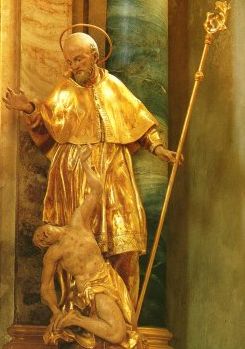|
Large sculpture in the Monastery Church St. Märgen in the Black Forest Photograph Max Galli  Museo alemán de epilepsia en Kork www.epilepsiemuseum.de |
As there was a profusion of idols in pagan times, it was difficult for the Church to represent Jesus Christ and the saints as figures in pictorial or plastic form. Above the altars there were usually only empty crosses and fish symbols. But as relics, which symbolised the presence of the saint "in persona" became increasingly popular, it became necessary to find fitting places to keep these items. In addition to shrines, busts and caskets, people also made figures which were partly hollowed out to keep the relic or the host in. It was not until after the year 1200 that sculptures were made for their own sake, and in the baroque period, they again became extremely popular. The monastery sculptor Matthias Faller, the son of a Black Forest farmer and the most gifted pupil of the Baroque sculptor Josef Anton Feuchtmayr, created in "his" church in St. Märgen several larger-than-life statues, including the golden statue of Saint Ubald of Gubbio, at whose feet a sick man writhes who appears to be having a grand mal seizure. |



